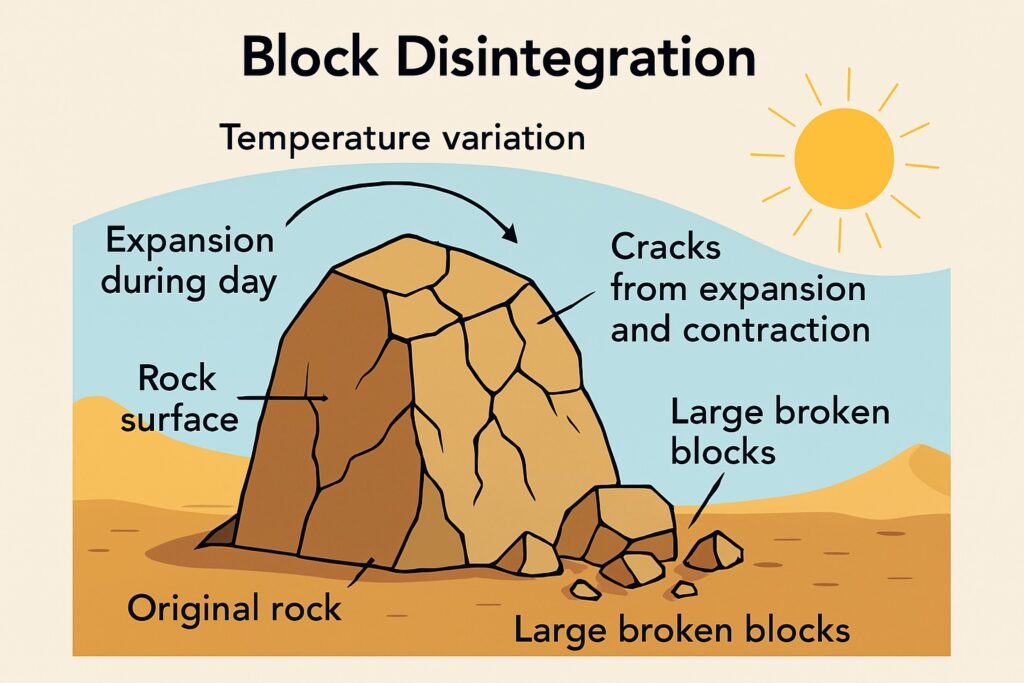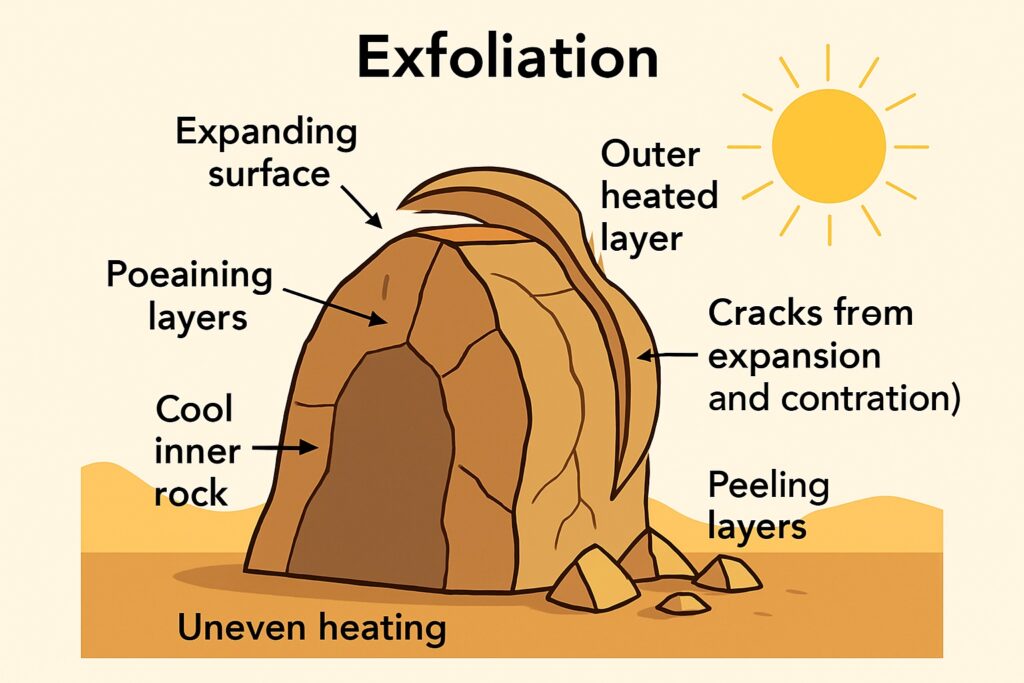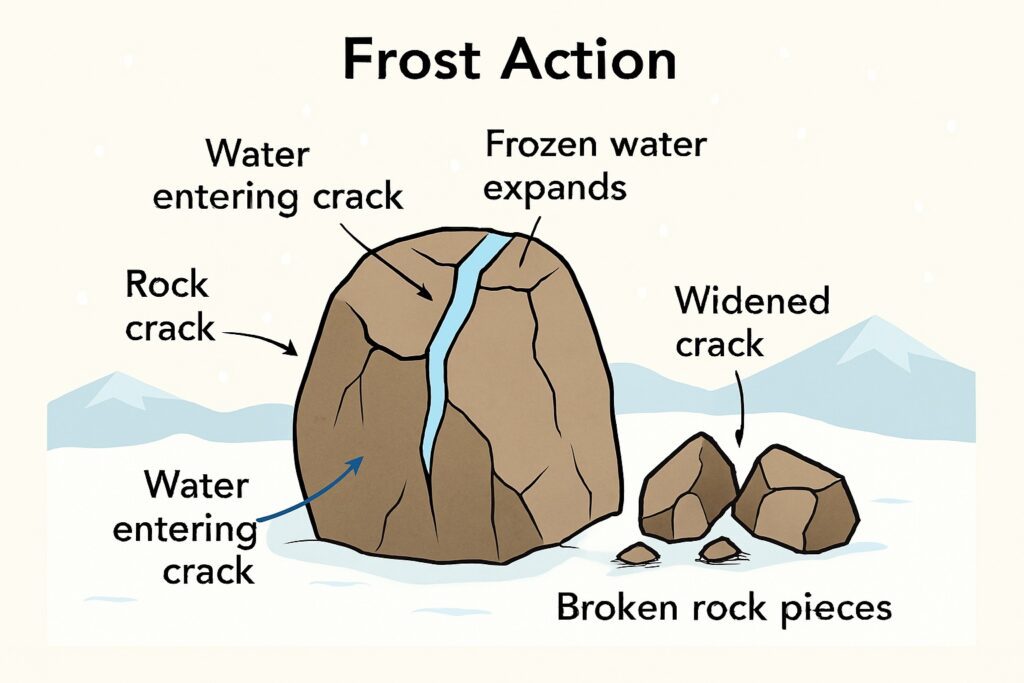The shape of the land is always changing. There are two main types of natural forces that cause this:
- Weathering – This is when rocks are broken down where they are, without being moved.
- Gradation – This involves moving broken rock pieces from higher areas to lower areas through things like rivers, wind, glaciers, and waves.
These two processes work together to change the land’s appearance and also help form soil.
Table of Contents
What is Weathering?
- Weathering is the breaking down of rocks that are exposed on the Earth’s surface.
- This happens because of natural forces like changes in temperature, rainfall, frost, fog, and ice.
- When rocks are exposed to these weather conditions, they slowly begin to break down at the place they are found.
- This breaking down process is local. The rocks do not get moved from their place during weathering.
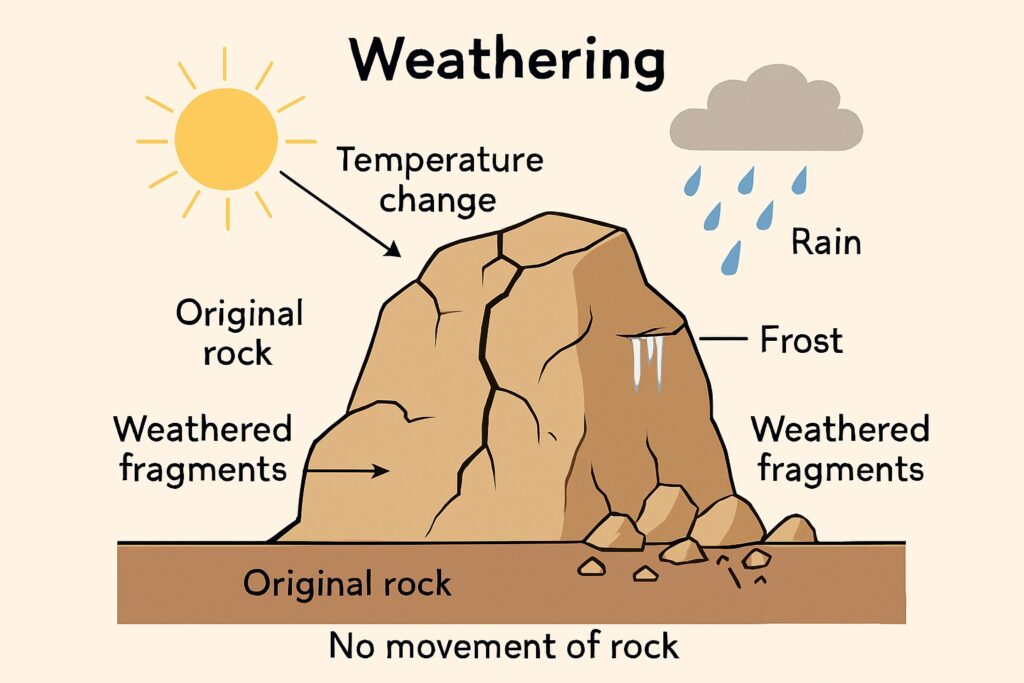
Types of Weathering
Weathering breaks down rocks in different ways. Based on how it happens, there are three types of weathering:
- Mechanical weathering
- Chemical weathering
- Biotic weathering
Mechanical Weathering
This happens when rocks break into smaller pieces without changing their chemical composition. It is most common in dry or cold regions.
Here are three main kinds of mechanical weathering:
- Block Disintegration: In hot deserts, rocks heat up during the day and cool down at night. This expansion and contraction creates cracks in the rocks. Over time, the rocks break into large blocks.

Block Disintegration - Exfoliation: Rocks do not allow heat to pass through easily. So, when the outer layer heats up more than the inside, it expands and peels off in layers, just like an onion. This is called exfoliation. It can be seen in places like Mahabalipuram and Jabalpur.

Exfoliation - Frost Action: In cold places, water enters the cracks in rocks. When it freezes, it expands and makes the cracks wider. Repeated freezing and melting causes the rocks to break apart.

Frost Action
Chemical Weathering
Chemical weathering happens when rocks change their chemical structure because of things like water, oxygen, and carbon dioxide. This kind of weathering is most common in places with warm and humid climates.
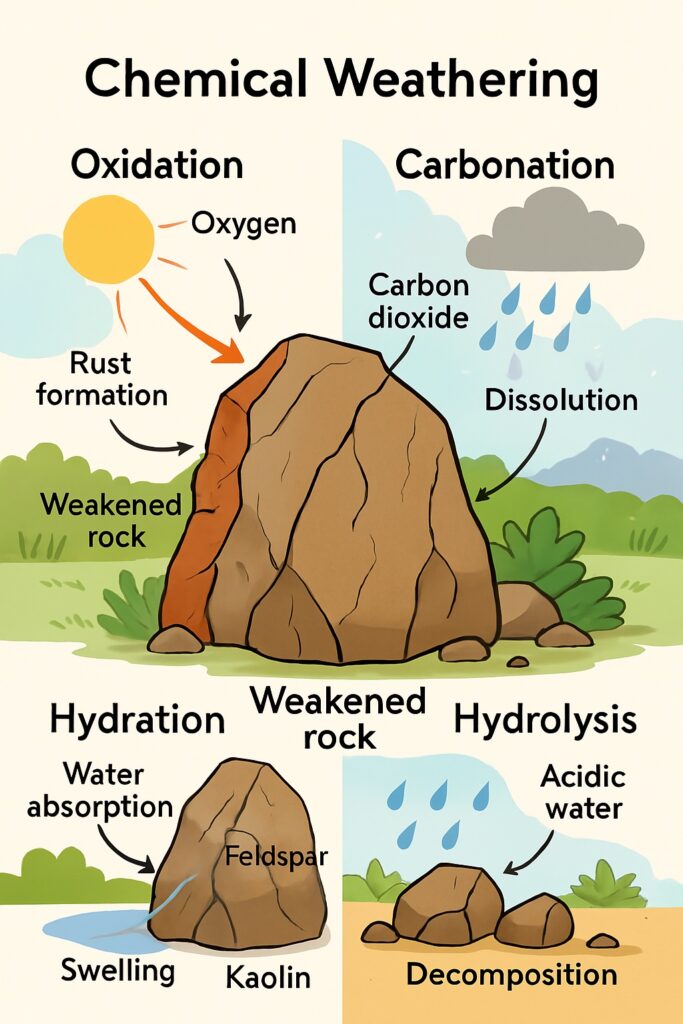
There are four main types of chemical weathering:
Oxidation: This occurs when oxygen in the air reacts with minerals in the rock—especially ones that contain iron—to form rust. Over time, the rust makes the rock weaker and causes it to break down.
Carbonation: When rainwater absorbs carbon dioxide, it becomes a weak acid called carbonic acid. This acid reacts with certain rocks, like limestone, and slowly dissolves them. The cracks in the rock get wider, and material is carried away in solution.
Hydration: In this process, minerals in the rock absorb water. As they absorb water, they swell up, change shape, and weaken. For example, the mineral feldspar can become a soft clay called kaolin through hydration.
Solution: Some minerals dissolve directly in water without any chemical reaction. Rocks like rock salt and gypsum break down in this way.
Biotic Weathering
Biotic weathering is caused by living organisms such as plants, animals, and humans. They help break down rocks both mechanically and chemically.
Plants
- Plant roots grow into the cracks of rocks.
- As the roots grow, they push the cracks open wider, which eventually causes the rocks to break apart.
- This is a type of mechanical weathering.
Animals
- Animals like earthworms, rats, rabbits, termites, and ants dig into the soil.
- This loosens and breaks rocks into smaller pieces.
- These broken pieces are easier to be moved by wind or water.
- Earthworms and termites are especially important because they can turn large amounts of rock into useful soil.
Humans
- Humans break rocks during activities like farming, building houses, constructing roads, and mining.
- All these actions weaken and break rocks, speeding up the weathering process.
Important point: Living things help in both breaking down rocks physically and changing them chemically.
Weathering and Soil Formation
We’ve already learned that weathering helps shape landforms. But it also plays a big role in forming soil, which is essential for farming and feeding the world.
Here’s how different types of weathering help create soil:
- Mechanical weathering breaks rocks into tiny particles and turns them into fine powder. Water helps move and settle these particles into layers.
- Biotic weathering—involving plants and animals—adds humus, which is the dark, rich organic matter that forms from dead plants and animals. Humus is important because it adds nutrients to the soil.
- Chemical weathering also changes the minerals in rocks, helping them become part of soil with different colors, textures, and properties.
So, all forms of weathering work together to form soil and give it the features that help crops grow.
Gradation
Gradation is the natural process of making the land surface more level over time.
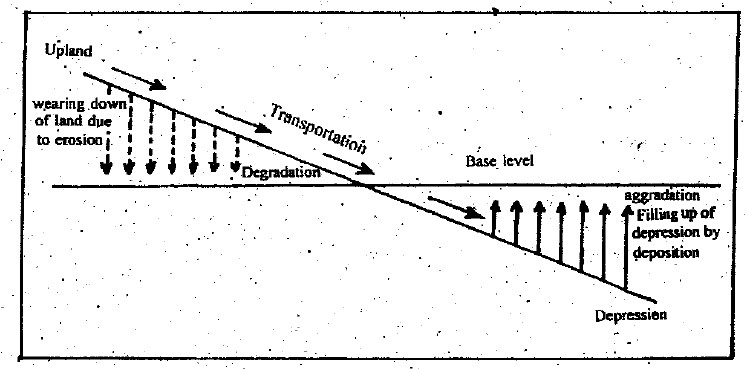
It happens because of external forces like:
- Rivers
- Winds
- Glaciers
- Sea waves
- Underground water
These forces shape the land using three actions: weathering, erosion, and deposition.
- Weathering weakens the rocks.
- Erosion wears them down and carries the pieces away.
- Deposition drops those pieces in low areas.
Eventually, the high areas get worn down and the low areas get filled up. This makes the land surface more even.
There are two parts to gradation:
- Degradation: This means lowering high areas through erosion and removal of rock materials.
- Aggradation: This means raising low areas by depositing materials that were carried from other places.
A land surface that is not changing anymore is said to be in a graded condition—but this is temporary, because Earth’s forces are always at work.
How Soil Forms
Soil is a thin top layer of the Earth’s surface made up of tiny mineral particles, decayed plants and animals, living organisms, water, and air. It forms slowly over a long time through natural processes. There are five main factors that control how soil forms:
Passive Factors
Parent Rock
- The parent material is the rock from which the soil comes.
- It affects the minerals, color, texture, and fertility of the soil.
- The rock gets broken down by mechanical, chemical, and biological weathering.
Relief (Shape and slope of the land)
- The slope affects how fast water flows over the land.
- Steep slopes have fast water run-off, less water sinking into the ground, and less soil development.
- Gentle slopes and flat lands form thicker, fertile soils.
Time
- Soil does not form quickly.
- It takes a very long time for all the processes to work and make mature, rich soil.
Active Factors
Climate
- Climate affects weathering, plant growth, and decay of organic matter.
- Even if the parent rocks are different, the same climate can lead to similar soils.
- For example, both granite and sandstone become sandy soil in dry Rajasthan.
Plants and Animals
- Dead plants and animals break down to make humus, which adds nutrients and moisture-holding ability to the soil.
- Plants also protect soil by reducing erosion and keeping moisture in the ground.
